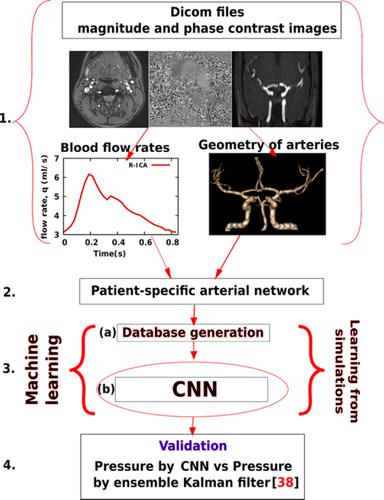当前位置:
X-MOL 学术
›
Int. J. Numer. Method. Biomed. Eng.
›
论文详情
Our official English website, www.x-mol.net, welcomes your
feedback! (Note: you will need to create a separate account there.)
Augmented patient-specific functional medical imaging by implicit manifold learning.
International Journal for Numerical Methods in Biomedical Engineering ( IF 2.2 ) Pub Date : 2020-03-06 , DOI: 10.1002/cnm.3325 Robert Rapadamnaba 1 , Franck Nicoud 1 , Bijan Mohammadi 1
International Journal for Numerical Methods in Biomedical Engineering ( IF 2.2 ) Pub Date : 2020-03-06 , DOI: 10.1002/cnm.3325 Robert Rapadamnaba 1 , Franck Nicoud 1 , Bijan Mohammadi 1
Affiliation

|
This paper uses machine learning to enrich magnetic resonance angiography and magnetic resonance imaging acquisitions. A convolutional neural network is built and trained over a synthetic database linking geometrical parameters and mechanical characteristics of the arteries to blood flow rates and pressures in an arterial network. Once properly trained, the resulting neural network can be used in order to predict blood pressure in cerebral arteries noninvasively in nearly real‐time. One challenge here is that not all input variables present in the synthetic database are known from patient‐specific medical data. To overcome this challenge, a learning technique, which we refer to as implicit manifold learning, is employed: in this view, the input and output data of the neural network are selected based on their availability from medical measurements rather than being defined from the mechanical description of the arterial system. The results show the potential of the method and that machine learning is an alternative to costly ensemble based inversion involving sophisticated fluid structure models.
中文翻译:

通过隐式流形学习增强了针对患者的功能性医学影像。
本文使用机器学习来丰富磁共振血管造影和磁共振成像采集。卷积神经网络是在合成数据库上构建和训练的,该数据库将动脉的几何参数和机械特性与动脉网络中的血流速度和压力相关联。经过适当的训练后,可以使用所得的神经网络以几乎实时地无创地预测脑动脉血压。这里的一个挑战是,并非从特定于患者的医学数据中知道合成数据库中存在的所有输入变量。为了克服这一挑战,我们采用了一种称为隐式流形学习的学习技术:在这种情况下,神经网络的输入和输出数据是基于其可从医学测量中获得的,而不是根据动脉系统的机械描述来定义的。结果显示了该方法的潜力,并且机器学习是包含复杂流体结构模型的基于代价高的集成反演的替代方法。
更新日期:2020-03-06
中文翻译:

通过隐式流形学习增强了针对患者的功能性医学影像。
本文使用机器学习来丰富磁共振血管造影和磁共振成像采集。卷积神经网络是在合成数据库上构建和训练的,该数据库将动脉的几何参数和机械特性与动脉网络中的血流速度和压力相关联。经过适当的训练后,可以使用所得的神经网络以几乎实时地无创地预测脑动脉血压。这里的一个挑战是,并非从特定于患者的医学数据中知道合成数据库中存在的所有输入变量。为了克服这一挑战,我们采用了一种称为隐式流形学习的学习技术:在这种情况下,神经网络的输入和输出数据是基于其可从医学测量中获得的,而不是根据动脉系统的机械描述来定义的。结果显示了该方法的潜力,并且机器学习是包含复杂流体结构模型的基于代价高的集成反演的替代方法。











































 京公网安备 11010802027423号
京公网安备 11010802027423号